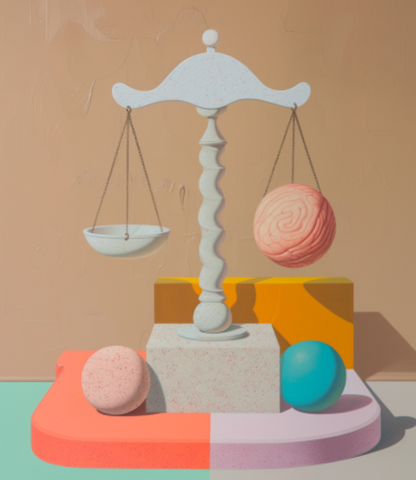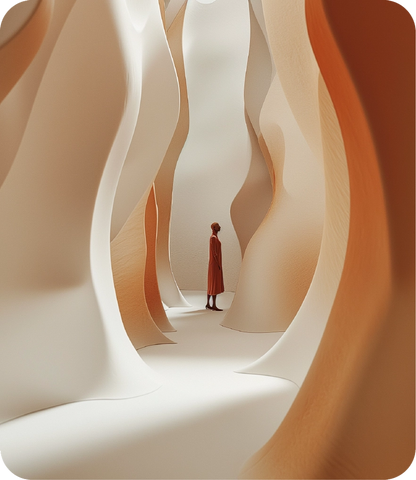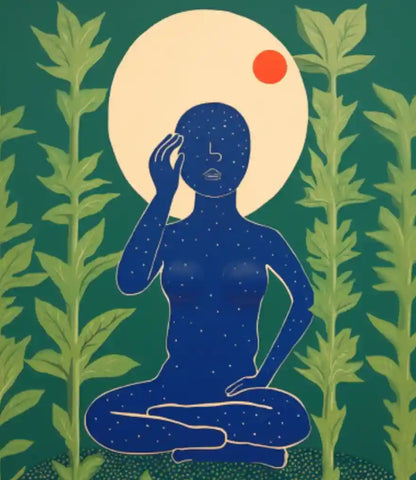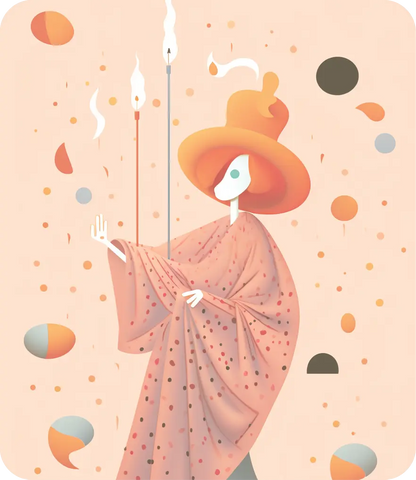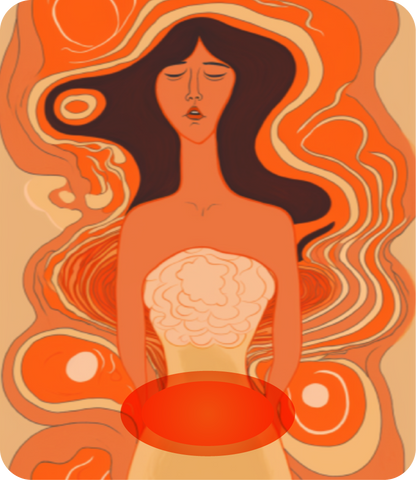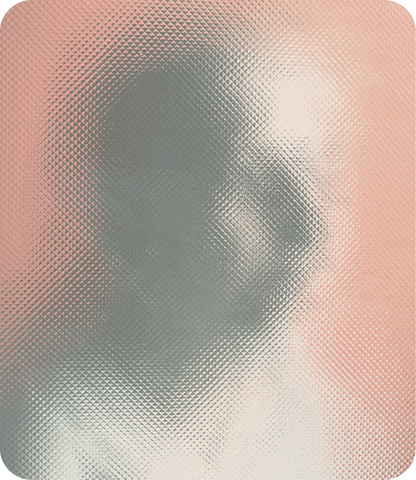
Rituals to Enhance Your Melatonin Production
In a world that thrives on constant connectivity and round-the-clock activity, the pursuit of a peaceful and rejuvenating night's sleep has become an elusive endeavor for many. Yet, amid the fast-paced routines and digital engagement, there exist two remarkably effective rituals that have the potential to unlock the secret to optimal melatonin production, an essential hormone responsible for regulating our sleep-wake cycles.
Our bodies, intricately attuned to the Earth's natural rhythms, dance to the tune of the circadian clock—a biological orchestra that manages our sleep, wakefulness, and numerous physiological processes. Amid the cacophony of artificial lighting and the glow of screens that accompany our modern lives, this natural rhythm can often fall out of sync.
By immersing ourselves in the wisdom of aligning with natural rhythms, we stand to reclaim the serenity of deep sleep and awaken to days infused with vitality. So, with curiosity as our guide, let us venture forth into the realm of melatonin modulation and circadian harmony, unlocking the potential to transform our nights and days alike.
Related to: Valerian Root: From Ancient Remedies to Modern Relaxation
The Dance of Melatonin and Light
In the intricate symphony of our biological processes, light serves as a conductor that guides our body's internal orchestra. At the center of this symphony lies melatonin, a hormone whose production is intricately interwoven with the presence and absence of light.
Melatonin, often referred to as the "hormone of darkness," wields its influence over our sleep-wake cycles with remarkable finesse. Its production follows a rhythm that closely mirrors the natural ebb and flow of light. As the sun sets and darkness envelops the world, our bodies interpret this absence of light as a signal to begin producing melatonin. This surge in melatonin levels induces a sense of tranquility, marking the onset of our journey into the realm of sleep.
Conversely, with the break of dawn and the gentle emergence of sunlight, melatonin production wanes. The presence of light, particularly the vibrant blue wavelengths found in daylight, communicates to our biological clock that it's time to awaken and embrace the vibrancy of a new day.
The Intrusion of Artificial Lighting
Yet, the harmony of this melatonin-light dance often faces discord in our modern lives. Artificial lighting, which extends well into the night, can disrupt this delicate rhythm. The intensity and composition of artificial light, mainly blue light emitted by screens and energy-efficient bulbs, can deceive our bodies into believing that daytime endures. As a result, our melatonin production may be delayed or suppressed, leading to difficulty falling asleep and compromised sleep quality.
The Sunrise-Sunset Connection
The importance of aligning our daily routines with the natural patterns of light cannot be overstated. Ancient wisdom and modern research converge to emphasize the significance of early exposure to sunlight, the original orchestrator of our circadian rhythms. By immersing ourselves in the soft glow of morning sunlight, we signal to our bodies that it's time to commence the day's melatonin production cycle. This sets the stage for a harmonious symphony where melatonin rises and falls in synchrony with the sun's journey across the sky.
In the heart of our bustling lives, where screens dominate and the rhythm of nature often fades into the background, there exists a simple yet profound ritual, one that invites us to rekindle a connection as old as time itself. This ritual, which entails deliberate exposure to the early rays of the sun, carries with it the potential to recalibrate our circadian rhythms and set the stage for optimal melatonin production.
Embracing the Dawn: A Ritual with Deep Roots
From the sun salutations of ancient yoga practices to the morning walks cherished by generations, the act of welcoming the day with open arms and an open heart resonates across cultures and epochs. This reverence for the sun is more than symbolic; it's a nod to the intricate relationship between our bodies and the celestial bodies that illuminate our world.
In cultures across the globe, the sunrise marks a pivotal moment, a juncture where darkness cedes to light, where the curtain of night lifts to reveal the brilliance of day. This transition is not only a feast for the eyes but a feast for our biology. The early morning sun, rich in blue light wavelengths, serves as a powerful entraining force for our internal clock, the circadian rhythm that orchestrates our sleep-wake cycles.
The Science Behind the Ritual
Modern scientific exploration has peeled back the layers of this age-old practice, revealing the intricate biological dance that unfolds when our skin is touched by the sun's tender embrace. As the morning light seeps into our retinas, specialized cells awaken, transmitting a signal to the suprachiasmatic nucleus—a minute region nestled within our brain that serves as the conductor of our body's circadian orchestra.
In response to this signal, a cascade of hormonal releases ensues. Melatonin production, the hormone of darkness, diminishes, while cortisol, the hormone of alertness, surges. This surge of cortisol sends a clear message to our body: it's time to awaken, to embrace the opportunities of the day ahead. As our cortisol levels rise, the symphony of our biological rhythm shifts from the tranquility of slumber to the vibrancy of wakefulness.
Related to : Xula’s Herbs: The Synergistic Approach to Our Formulas
Morning Sunlight Ritual: Embrace the Dawn
The beauty of this ritual lies in its simplicity. Incorporating early sunlight exposure into your daily routine doesn't necessitate grand gestures. A few minutes spent outside during the early hours can suffice. Whether it's a stroll, a peaceful meditation in the garden, or savoring your morning coffee on a sunlit balcony, each act draws you closer to the sun's nurturing energy.
- Start Small, Build Gradually: Begin by dedicating a few minutes each morning to early sunlight exposure. As the sun's tender rays touch your skin, embrace the connection to nature and the cues it imparts to your internal clock.
- Create a Morning Sanctuary: Designate a peaceful space where you can welcome the day's first light. Whether it's your balcony, garden, or a nearby park, ensure it's a space that invites stillness and reflection.
- Morning Ritual Integration: Incorporate the morning sunlight exposure into your daily routine. Consider pairing it with other practices like meditation, journaling, or a mindful breakfast to create a comprehensive morning ritual that grounds your day.
It's important to note that the intensity of sunlight varies with geographical location and time of year. As such, the duration of exposure required can differ. Resources that guide optimal sunlight exposure based on your site can aid in fine-tuning this ritual to your unique circumstances.
As you step into the gentle embrace of the morning sun, you're not only nurturing your body but also honoring the symphony of existence. By syncing your biological rhythms with the sun's celestial journey, you align with the very pulse of life. Through this practice, you invite your melatonin production to dance in synchrony with the sun's radiant cadence—a dance that promises serenity in the night's embrace and vibrancy in the light of day.
Shielding the Night: The Battle Against Blue Light
Amid the digital age's relentless glow, where screens have seamlessly infiltrated every corner of our lives, the line between day and night has blurred. However, within this intricate tapestry of modern existence, a potent ritual awaits one that empowers us to reclaim the sacred realm of the night. This ritual, a deliberate effort to reduce exposure to blue light during the evening hours, emerges as a beacon guiding us back to the rhythms of nature.
In our quest for connectivity and constant engagement, blue light has emerged as both an ally and an adversary. This high-energy wavelength, abundant in the screens we rely upon and the energy-efficient lighting we employ, wields a dual nature. While it illuminates our surroundings and digital devices, it also possesses the power to obscure the innate rhythms that govern our bodies. The key lies in its spectral composition, which mirrors the blue light present in daylight, the very light that serves as a signal to our internal circadian clock to awaken.
When we subject ourselves to blue light in the evening, whether from smartphones, tablets, or computers, we unwittingly send our bodies a false signal, an assertion that daylight persists. This deceptive input disrupts the delicate dance of melatonin production, hindering the hormone's release. Melatonin, often dubbed the "hormone of darkness," is responsible for inducing a state of relaxation and preparing our bodies for the restorative slumber that awaits. Consequently, our bodies remain in a state of alertness, thwarting the natural progression into restful sleep.
Blocking the Intruder: Strategies for Blue Light Reduction
To confront the intrusive influence of blue light during the evening hours, an array of strategies stands ready to bolster our defenses. One approach involves the integration of blue light filters or software applications that adjust the color temperature of screens as the day wanes. These digital sentinels mirror the natural shift from blue-rich light during the day to warmer, more calming tones reminiscent of twilight.
Another effective ally in this endeavor is the use of blue-light-blocking glasses. Available in various styles and tints, these specialized eyeglasses filter out or diminish blue light, allowing you to engage with screens while safeguarding your body's circadian rhythm. These glasses are more than a fashion statement; they're a practical tool that enables you to navigate the digital world while minimizing interference with your melatonin production.
Creating a Sanctuary: Evening Rituals for Blue Light Reduction
Beyond technological solutions, the creation of a technology-free sanctuary in the evening can profoundly enhance the efficacy of this ritual. As the sun dips below the horizon, consider embarking on activities that embrace the soothing glow of ambient lighting. Engage in reading a physical book, indulge in gentle stretching, or immerse yourself in a serene conversation. By intentionally dimming the lights and limiting screen exposure, you craft an environment conducive to melatonin production and a seamless transition into the realm of sleep.
- Set the Stage for Evening: As the day winds down, transition your environment to a softer, dimly lit ambiance. This gradual reduction in lighting mimics the transition from daylight to twilight, signaling your body that it's time to prepare for sleep.
- Digital Sunset: An hour or two before bedtime, establish a "digital sunset." During this time, minimize screen usage and consider incorporating activities that are conducive to relaxation—reading a physical book, engaging in light stretching, or enjoying a calming cup of herbal tea.
- Blue Light Filters and Glasses: Leverage the power of technology to protect your circadian rhythm. Implement blue light filters on your devices or don blue-light-blocking glasses to reduce the impact of screens on your melatonin production.
As you embrace the practice of blocking blue light at night, you embark on a journey that extends beyond protecting your biological rhythms. You are embarking on a journey to reclaim the sacred realm of the night, a realm that beckons with introspection, rejuvenation, and the allure of dreams. This ritual, when intertwined with the practice of early sunlight exposure, forms a powerful symphony, guiding your circadian rhythm through the crescendo of day and the serenity of night.
A Dance of Light and Dark: The Power of Synergy
In the realm of circadian rhythms, where the dance of light and darkness choreographs our every move, the practices of early sunlight exposure and nighttime blue light reduction emerge as twin pillars of harmony. By seamlessly weaving these rituals into the fabric of our lives, we unlock the potential for a profound symphony, one that orchestrates optimal melatonin production and a balanced sleep-wake cycle.
The morning sun, with its gentle touch, serves as the overture to the day's melatonin symphony. As we absorb its luminous embrace, our body's internal clock receives a vital cue, an affirmation that the day has begun. This message is transmitted through the reduction of melatonin production and the rise of cortisol, the hormone that sparks wakefulness.
As the day unfurls its tapestry, the delicate balance shifts. Evening approaches, and with it, the need for a gentle transition into the serenity of sleep. This is where the ritual of blocking blue light assumes its role. By curtailing our exposure to blue light during the evening hours, we honor the melatonin symphony's intricate notes, allowing them to crescendo with tranquility.
The Power of Synchronization
The true magic lies in the synergy between these rituals. By basking in the early sunlight, we awaken our body's internal clock to the day's cadence. This, in turn, primes our circadian rhythm for the nocturnal melody, the lullaby of melatonin production. By reducing blue light intrusion in the evening, we protect and enhance the hormone's delicate dance, ensuring it reaches its crescendo at the right time.
When these two rituals coalesce, a harmony emerges a harmony that echoes the symphony of the natural world. This harmonious dance between light and darkness not only optimizes our melatonin levels but also creates a profound sense of alignment with the circadian rhythms that have guided humanity for millennia.
Creating Your Rhythmic Symphony
Incorporating these rituals need not be a complex endeavor. It's a journey that starts with intention and unfolds through small, deliberate actions. Begin by dedicating a few minutes each morning to absorb the early sunlight, whether through a morning stroll, meditation, or simply enjoying breakfast outdoors. As evening approaches, embrace the soft glow of ambient lighting, reducing screen time and gradually transitioning into activities that soothe the mind.
By weaving these practices into your daily routine, you sculpt a symphony of rhythm that is uniquely yours, one that bridges the harmony of the natural world with the cadence of your life. As you align with the sun's journey and protect the sanctity of your body's internal clock, you gift yourself the tranquility of sleep and the vitality of wakefulness.
- Mindful Consistency: While the rituals might seem simple, their impact lies in their consistent practice. Aim to integrate both practices into your routine daily to allow your body to adjust and respond to the natural cues.
- Adapt to Your Schedule: While mornings filled with sunlight are ideal, life's demands might not always align. Adapt the rituals to fit your schedule, making adjustments to ensure you still receive the benefits of these practices.
- Personalize Your Approach: Every individual's lifestyle is unique. Personalize the rituals to align with your preferences and needs. The goal is to create a harmonious flow that supports your overall well-being.
As you embark on this journey of ritual integration, remember that it's not about perfection but about progress. The practices of early sunlight exposure and nighttime blue light reduction are not isolated actions; they're threads woven into the fabric of your life. With each sunrise you greet and every moment you spend nurturing your body's rhythms, you're creating a symphony of balance, a melody that resonates with the natural world and the symphony of your being.
With this knowledge, you'll be equipped to embark on a transformative path toward optimizing your melatonin production and rekindling a harmonious relationship with your sleep-wake cycles.
Related to: Everything you need to know about Insomnia
Sources
Mead MN. Benefits of sunlight: a bright spot for human health. Environ Health Perspect. 2008 Apr;116(4):A160-7. doi: 10.1289/ehp.116-a160.
(n.d.). Blue light has a dark side. Harvard Health Publishing. https://www.health.harvard.edu/staying-healthy/blue-light-has-a-dark-side
(n.d.). Blue Light and Sleep: What's the Connection? Healthline. https://www.healthline.com/nutrition/block-blue-light-to-sleep-better
(n.d.). The benefits of light exposure for performance optimization and military wellness. Human Performance Resources. https://www.hprc-online.org/mental-fitness/sleep-stress/benefits-light-exposure-performance-optimization-and-military-wellness#:~:text=Early%20exposure%20to%20morning%20sunlight,keep%20lights%20on%20after%20sunset




